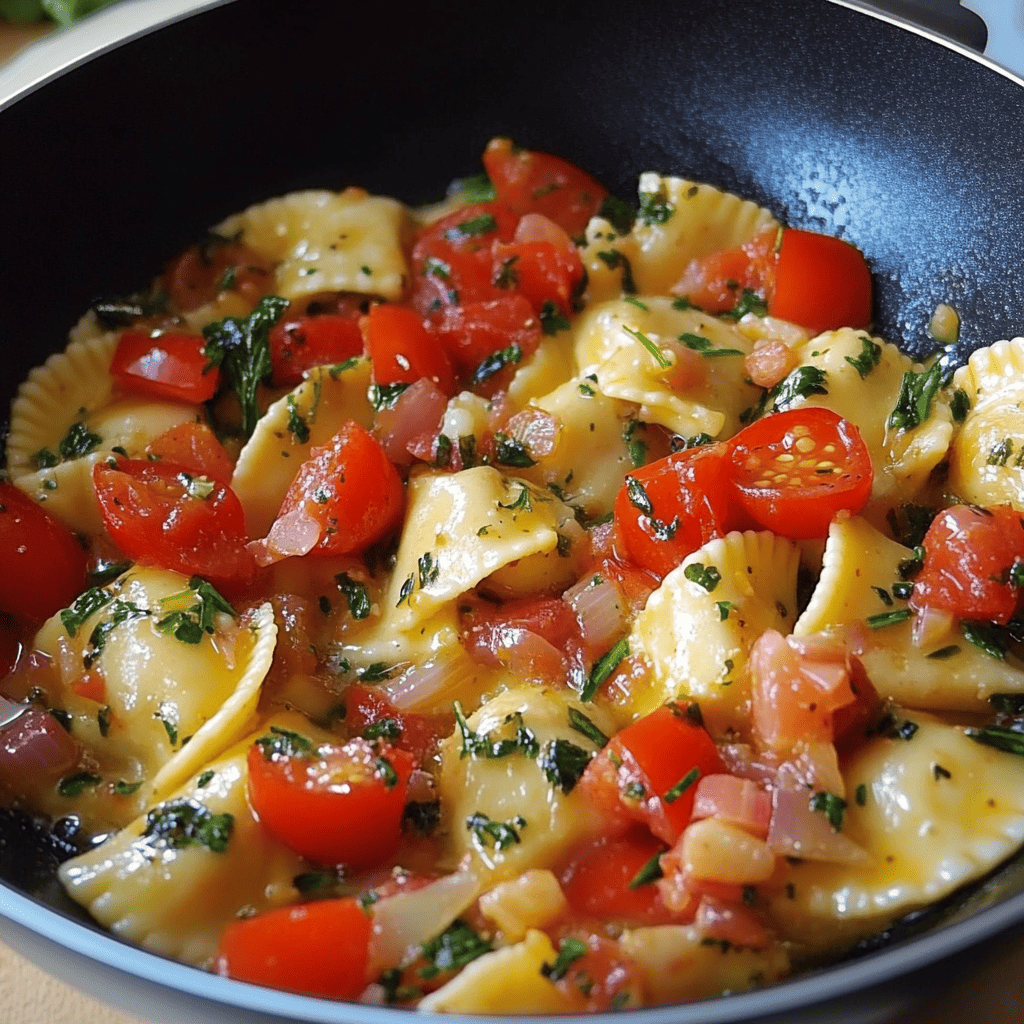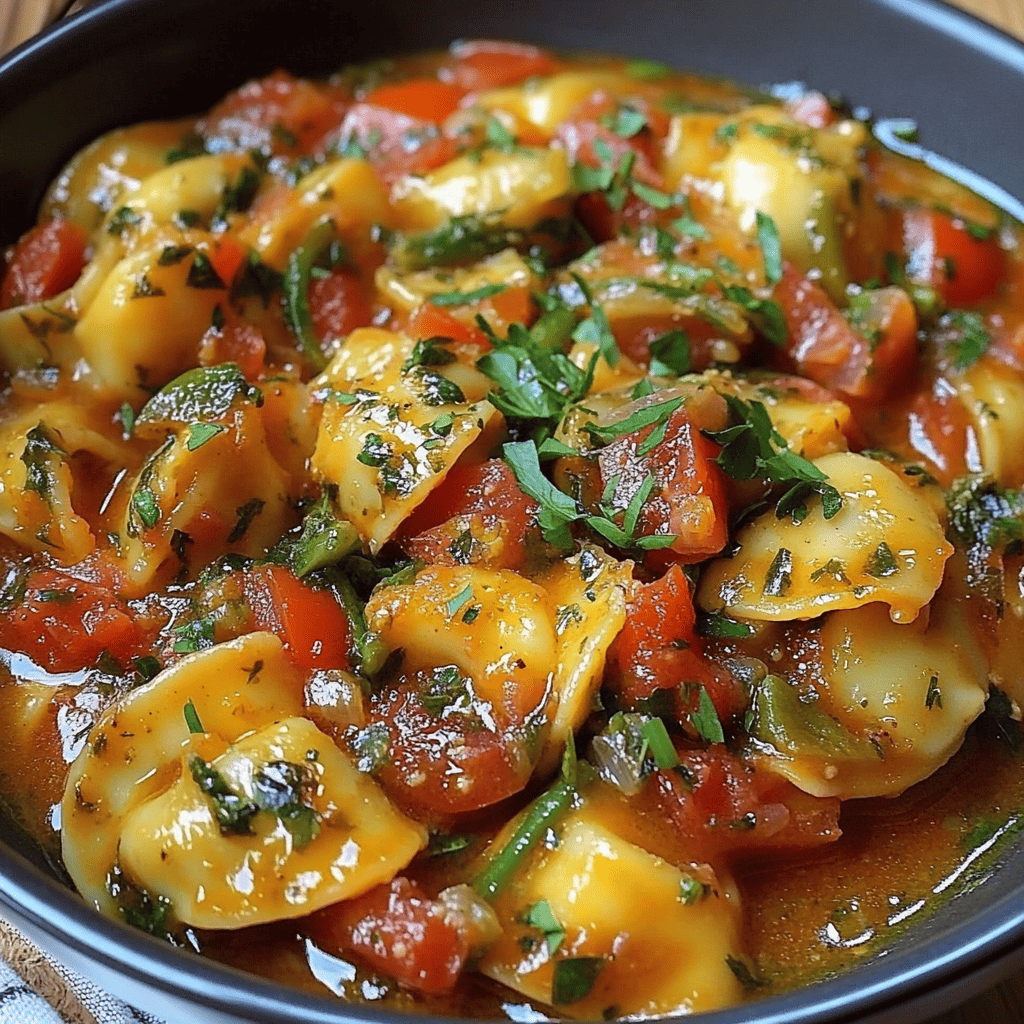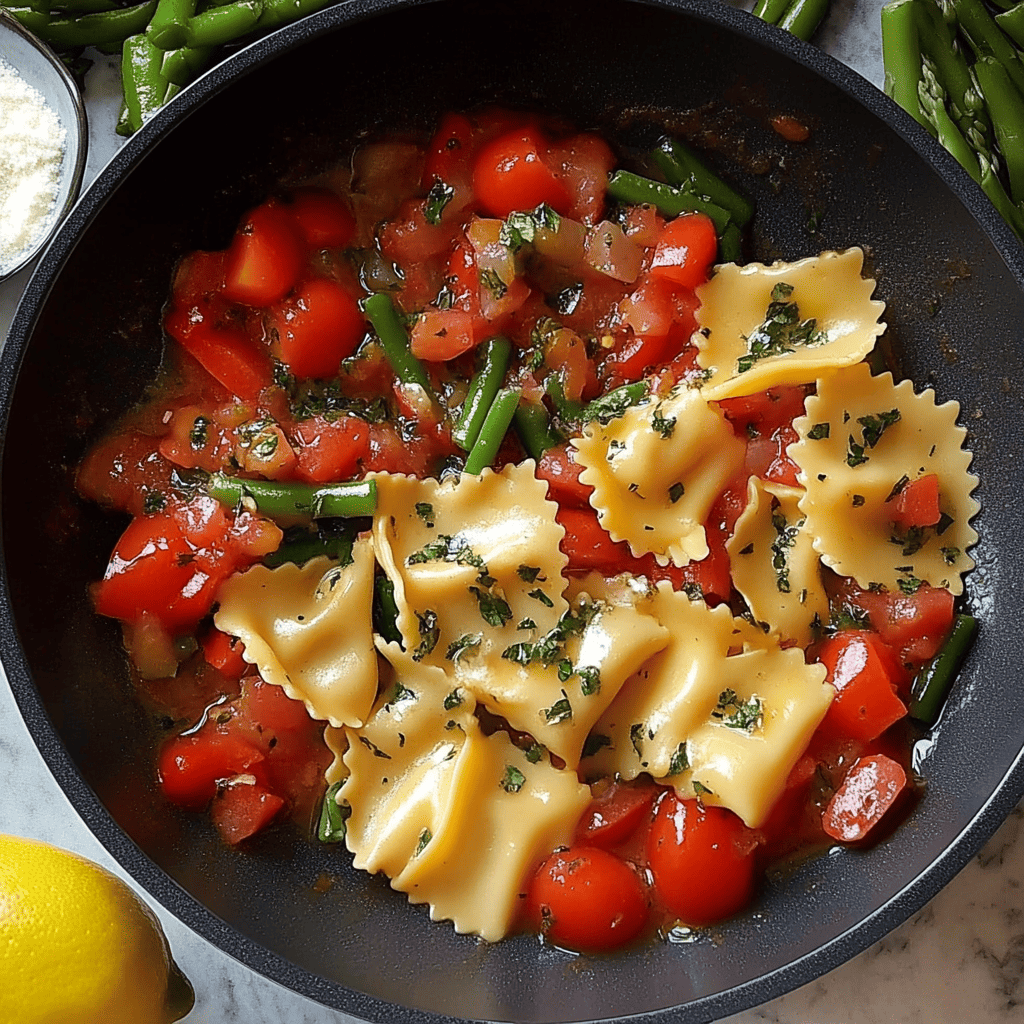Ravioli with Tomatoes, Asparagus, Garlic and Herbs: A Symphony of Mediterranean Flavors
Introduction: An Italian Classic Reborn with Spring Freshness
“Ravioli with Tomatoes, Asparagus, Garlic, and Herbs,” as seen in the image, is a perfect example of how simplicity in Italian cuisine can result in extraordinarily delicious and visually stunning dishes. This recipe combines the richness of cheese ravioli with the lightness and freshness of seasonal vegetables, enhanced by aromatic garlic and fresh herbs. It’s a dish that evokes the warmth of home and the sophistication of Mediterranean cuisine, ideal for a quick weeknight meal or a special dinner. Discover all the secrets of this preparation that you’ll love for its simplicity, speed, and delicious results!
Detailed History in Spanish: From the Origins of Ravioli to the Combination of Fresh Flavors
The story of “Ravioli with Tomatoes, Asparagus, Garlic, and Herbs” is a confluence of the rich tradition of Italian stuffed pasta and the versatility of fresh, seasonal ingredients, especially those that are pillars of the Mediterranean diet.
Ravioli: A Journey Through the History of Italian Pasta: Ravioli (or ravioli in plural) is one of Italy’s oldest and most iconic forms of stuffed pasta. Its origins date back to the Middle Ages, with the first written references dating back to 14th-century Venice. Originally, ravioli were not always filled with cheese or meat; they often contained herbs, spices, and vegetables, and were cooked in broth or served with simple sauces. Each region of Italy developed its own versions, varying the fillings and sauces according to locally available ingredients and family traditions. Cheese ravioli is one of the most classic and popular versions, widely available and beloved.
Cherry Tomatoes: A New World Import That Conquered Italy: Although tomatoes are synonymous with Italian cuisine, they didn’t arrive in Europe until after the discovery of America. Originally, they were considered poisonous or merely decorative. It wasn’t until the 18th century in southern Italy that they began to be incorporated into the diet, revolutionizing gastronomy. Cherry tomatoes, with their concentrated sweetness and small size, are perfect for quick sautéing and adding a touch of freshness and color to pasta dishes.
Asparagus: An Ancient Delicacy and Symbol of Spring: Asparagus has an even older history, having been cultivated in the eastern Mediterranean for over 2,000 years. It was prized by the Egyptians, Greeks, and Romans for its delicate flavor and medicinal properties. In Europe, it became very popular in royal courts and, eventually, in home cooking. It is an emblematic vegetable of spring, valued for its distinctive flavor and tender yet slightly crunchy texture when cooked properly. Its ability to cook quickly makes it ideal for pasta dishes.
Garlic and Fresh Herbs: The Aromatic Heart of Mediterranean Cuisine: Garlic is a fundamental ingredient in almost all Mediterranean cuisines, prized for its powerful aroma and flavor. Fresh herbs such as basil and parsley are also essential, providing freshness, color, and an aromatic depth that enhances the flavors of the other ingredients. Basil is a classic pairing with tomatoes, while parsley is an excellent finishing touch.
Fusion in a Modern Dish: The combination of cheese ravioli with cherry tomatoes and asparagus is a relatively modern creation, taking advantage of the convenience of refrigerated ravioli and the availability of fresh produce. It’s a dish that reflects a trend toward lighter, faster, and healthier meals that don’t sacrifice flavor. The simplicity of the sauce—made with olive oil, chicken broth, and lemon juice—allows the natural flavors of the vegetables and cheese to shine, rather than being overshadowed by heavy sauces. This minimalist yet flavorful approach is a hallmark of “nouveau Italiane” or contemporary Mediterranean cuisine, which values the quality of ingredients above all else.
In short, “Ravioli with Tomatoes, Asparagus, Garlic, and Herbs” is a dish that honors the Italian traditions of stuffed pasta, but adapts to modern tastes and lifestyles, offering a quick, fresh, and flavorful meal, perfect for any food lover.
More Historical Detail: The Evolution of Pasta and the Emphasis on Fresh
Digging a little deeper into the history and cultural significance of “Ravioli with Tomatoes, Asparagus, Garlic, and Herbs,” we can highlight:
- Stuffed Pasta as a Celebratory Food: Historically, stuffed pasta, including ravioli, was often a more elaborate preparation, reserved for special occasions, holidays, or Sundays. Creating the pasta from scratch and its filling required time and skill, making it a dish of value and celebration. Today, with the availability of refrigerated or frozen ravioli, this dish has become more popular, allowing this delicacy to be enjoyed anytime.
- The Role of Extra Virgin Olive Oil: Olive oil, especially extra virgin olive oil, is more than just a fat in Mediterranean cuisine; it’s a central ingredient that provides flavor, texture, and health benefits. In dishes like this, where the sauce is light, the quality of the olive oil is crucial, as its flavor becomes a key component.
- The Importance of Seasonal Ingredients: The freshness of the asparagus and cherry tomatoes is essential to the success of this dish. Mediterranean cuisine is characterized by the use of seasonal ingredients, ensuring the best flavor and nutritional value. This dish reflects that philosophy, celebrating the arrival of spring with asparagus and summer with tomatoes.
- Chicken Broth as a Light Base: Using chicken broth instead of a creamy or heavy tomato-based sauce is a choice that underscores the dish’s lightness. The broth adds depth of flavor without overwhelming the main ingredients, allowing the sweetness of the tomatoes and the earthiness of the asparagus to shine.
- Lemon Juice: A Bright Touch: Adding lemon juice is a clever culinary technique that adds acidity and brightness, enhancing the flavors of herbs and vegetables. It’s a common trick in Mediterranean cuisine to add freshness to dishes without making them heavy.
This dish is an excellent example of the evolution of Italian cuisine toward a fresher, more health-conscious expression, while always maintaining respect for quality ingredients and the tradition of flavor.

Ingredients & Detailed Preparation
Ingredients:
- Extra virgin olive oil: 1 tablespoon
- Asparagus, woody ends trimmed, cut into 2-inch pieces: 1 lb (approx. 450 g)
- Cherry tomatoes, halved: 2 cups (approx. 300 g)
- Garlic cloves, finely chopped: 3 pieces
- Fine sea salt: to taste
- Freshly ground black pepper: to taste
- Low sodium chicken broth: ¼ cup (approx. 60 ml)
- Fresh lemon juice: 1 tablespoon
- Fresh basil, chopped: ¼ cup
- Fresh parsley, chopped: ¼ cup
- Grated Parmesan cheese, plus more for serving: ¼ cup
- Refrigerated Cheese Ravioli: 1 package (20 oz / approx. 560 g)
Necessary equipment:
- Large pot for cooking pasta
- Large frying pan (preferably deep or a wok)
- Sharp chef’s knife
- Cutting board
- Wooden spoon or spatula
- Pasta tongs
- Cheese grater (optional, to grate cheese on the spot)
- Deep serving plate
Detailed Preparation:
- Prepare the ingredients: Before you start cooking, make sure you have all the ingredients measured and chopped. This will speed up the process: trim the asparagus and cherry tomatoes, chop the garlic, basil, and parsley. Grate the Parmesan cheese if you don’t have it already.
- Cook the asparagus and tomatoes: Heat the tablespoon of olive oil in a large skillet over medium-high heat. Add the asparagus and sauté for 3-5 minutes, or until crisp-tender and bright green. Add the halved cherry tomatoes and sauté for 2-3 more minutes, until they begin to soften slightly.
- Add the garlic and season: Add the minced garlic to the pan and cook for 1 more minute, stirring constantly to prevent burning (burnt garlic makes it bitter). Season generously with salt and pepper to taste.
- Make the light sauce: Pour the chicken broth and lemon juice into the pan with the vegetables. Bring to a gentle boil and cook for 1-2 minutes, scraping the bottom of the pan to deglaze any flavors that may have settled. This will create a light and flavorful sauce.
- Cook the ravioli: While the sauce is cooking, bring a large pot of salted water to a boil (as if you were cooking pasta). Once the water is boiling vigorously, add the cheese ravioli. Cook according to the package instructions (usually 3-5 minutes for refrigerated ravioli), until al dente (tender but firm to the bite).
- Combine the ravioli and sauce: Using a slotted spoon or pasta tongs, transfer the cooked ravioli directly from the pot to the pan with the vegetable sauce. It’s not necessary to drain them completely, as a little of the pasta cooking water will help emulsify the sauce.
- Stir in herbs and cheese: Add the chopped fresh basil, chopped fresh parsley, and 1/4 cup grated Parmesan cheese to the pan. Gently toss to combine all the ingredients, making sure the ravioli are well coated with the sauce and vegetables.
- Serving: Divide the ravioli among bowls. Drizzle with an additional drizzle of extra-virgin olive oil (optional, but recommended to enhance the flavor) and sprinkle with more grated Parmesan cheese.
Estimated Preparation Time
- Active preparation (chopping, sautéing, mixing): 20-25 minutes
- Cooking time (ravioli): 3-5 minutes
- Total time: Approximately 25-30 minutes.
Additional Tips
- Quality of ingredients: Since the dish is simple, the quality of the ingredients (especially the olive oil, asparagus, and tomatoes) will make a big difference in the final flavor.
- Fresh, tender asparagus: Look for asparagus with firm stalks and closed tips. To remove the woody ends, bend the stalk until it snaps naturally.
- Don’t overcook the asparagus: You want the asparagus to be tender but still have a slight bite. Quick sautéing is key.
- Adjust the seasoning: Taste the dish before serving and adjust the salt and pepper if necessary. Parmesan cheese also adds saltiness.
- Ravioli al dente: Cook the ravioli just until they are al dente. They will cook a little longer when mixed with the hot sauce.
- Herb Variations: You can add other fresh herbs like oregano or thyme if you like, but basil and parsley are classics.
- Spicy touch: For a touch of spice, add a pinch of red chili flakes when sautéing garlic.

Frequently Asked Questions
- Can I use frozen ravioli? Yes, you can use frozen ravioli. Just cook them according to the package instructions, which may be slightly longer than for refrigerated ravioli.
- What other vegetables can I add? Mushrooms, diced zucchini, or fresh spinach would all work well in this sauce.
- Can I use another type of pasta? If you don’t have ravioli, this sauce works great with other short pastas like penne, fusilli, or farfalle, or even long pasta like linguine or spaghetti.
- Can I make this dish vegan? Yes, use vegan ravioli (available at many stores), vegetable broth instead of chicken broth, and vegan Parmesan cheese or nutritional yeast instead of the Parmesan cheese.
- How do I keep the sauce from drying out? Make sure you don’t overcook the broth after adding it, and don’t drain the cooking water completely from the ravioli, as the starch in that water helps create a silky sauce.
Texture and Flavor
The texture of this dish is a multisensory delight: the ravioli are soft and tender, with a creamy cheese filling. The asparagus provides a delicate yet firm crunch, while the gently cooked cherry tomatoes burst with gentle juiciness. The chopped herbs add a touch of freshness that contrasts with the creaminess.
The flavor is fresh, bright, and balanced. The cheese ravioli offer a rich and savory base. The cherry tomatoes, with their natural sweetness, are enhanced by the spicy touch of garlic. The asparagus contributes an earthy, slightly bitter flavor balanced by the acidity of the lemon and the saltiness of the cheese. The fresh herbs, basil and parsley, infuse a herbaceous aroma and vibrant flavor that perfectly complements the Mediterranean profile of the dish. It’s a comforting bite, yet light and full of life.
Consumer Context
This dish is ideal for:
- Main Meal: A complete and satisfying meal.
- Quick dinner: Prepares in less than 30 minutes, ideal for a busy weeknight.
- Casual Dinner: Elegant but not pretentious, perfect for entertaining friends.
- Spring/Summer Food: Uses fresh, seasonal ingredients that make it light and refreshing.
- Lunch prep: Leftovers can be easily reheated.
Visual Aspect
The image captures the essence of a fresh and vibrant dish. The golden, slightly translucent ravioli are the canvas on which the vivid colors of the vegetables are arranged. The deep red of the halved cherry tomatoes leaps out, contrasting beautifully with the bright, crisp green of the asparagus. Small flecks of chopped fresh herbs (possibly basil and parsley) are generously distributed, adding texture and a touch of dark color. The dish is lightly glazed with a glossy sauce, possibly olive oil with the juices from the vegetables, giving it a moist, appetizing appearance. Every element is clearly visible, making the dish incredibly appealing and promising.
Curiosities
- Ravioli around the world: Although they are Italian, stuffed pasta is common in many cultures: Polish pierogi , Chinese dumplings , Korean mandu , and Latin American empanadas are some examples.
- Benefits of asparagus: Asparagus is rich in vitamins K, A, C, E, folic acid, and fiber. It is also a good source of antioxidants.
- The magic of the “bottom of the pan”: Deglazing the pan with chicken broth takes advantage of the caramelized flavors that cling to the bottom of the pan after sautéing the vegetables, adding depth to the sauce.
Nutritional Value (Estimated per Serving)
These values are approximate and may vary significantly depending on the serving size and brand of ravioli. Let’s assume a generous serving (approximately 1/4 of the package of ravioli + vegetables).
- Calories: 400-550 kcal (depending on serving size and amount of oil/cheese)
- Carbohydrates: 50-70 g (mainly from the ravioli)
- Sugars: 5-10 g (from the tomatoes and some in the broth)
- Fat: 15-25 g (from the ravioli cheese, olive oil, and Parmesan cheese)
- Saturated fat: 5-10 g
- Protein: 15-25 g (from ravioli and cheese)
- Fiber: 5-8 g (from asparagus and tomatoes)
- Sodium: Variable (from ravioli, broth, salt and Parmesan cheese)
- Vitamins and minerals: Excellent source of vitamins (K, C, A, E, folate) and minerals (potassium) from vegetables, and calcium from cheese.
Additional Benefits and Interesting Facts
- “Real” Food: This dish relies on fresh, minimally processed ingredients, making it a healthy choice.
- Easy to customize: The recipe is an excellent base for adding protein (grilled chicken, shrimp) or more vegetables.
- Ideal for vegetarians: Naturally vegetarian (if the cheese ravioli does not contain animal by-products).
- Versatility: It can be served as a single dish or as a side dish to a main course.
Other Information
- Wine Pairing: A light, crisp white wine like a Sauvignon Blanc or Pinot Grigio would complement the flavors of this dish very well.
- Presentation: For a more elegant presentation, you can garnish each plate with a sprig of fresh basil or a drizzle of balsamic glaze.

Conclusion: Mediterranean Freshness in a Pasta Dish
“Ravioli with Tomatoes, Asparagus, Garlic, and Herbs” is a celebration of Italian cuisine at its freshest and most accessible. It combines the indulgence of stuffed pasta with the vibrancy of seasonal vegetables, all bathed in a light yet flavorful sauce. It’s a dish that proves you don’t need complexity to create a memorable and delicious culinary experience. Its speed and simplicity make it perfect for any occasion, bringing a taste of Mediterranean joy straight to your table. Go ahead and prepare it and enjoy this explosion of colors and flavors!

